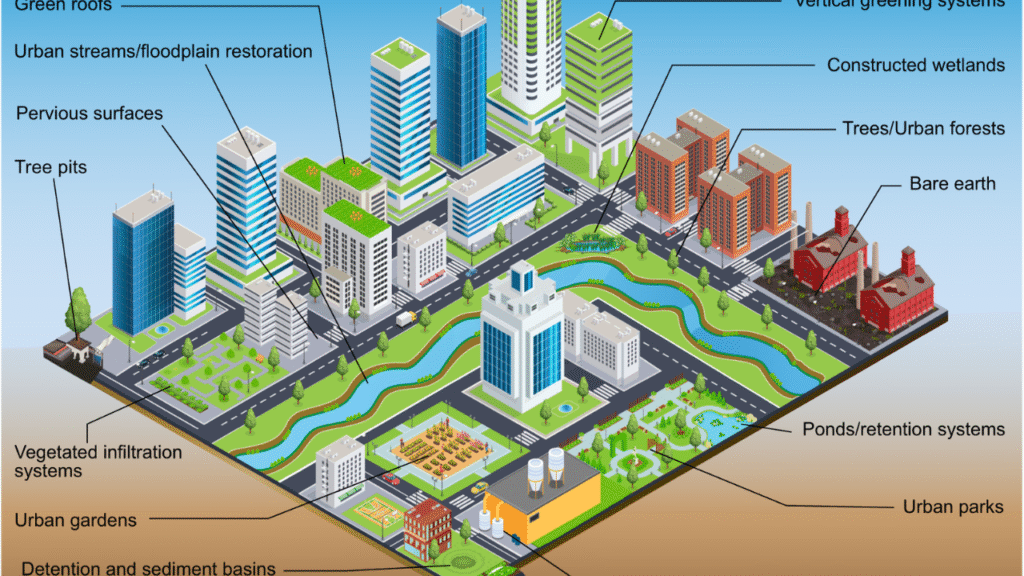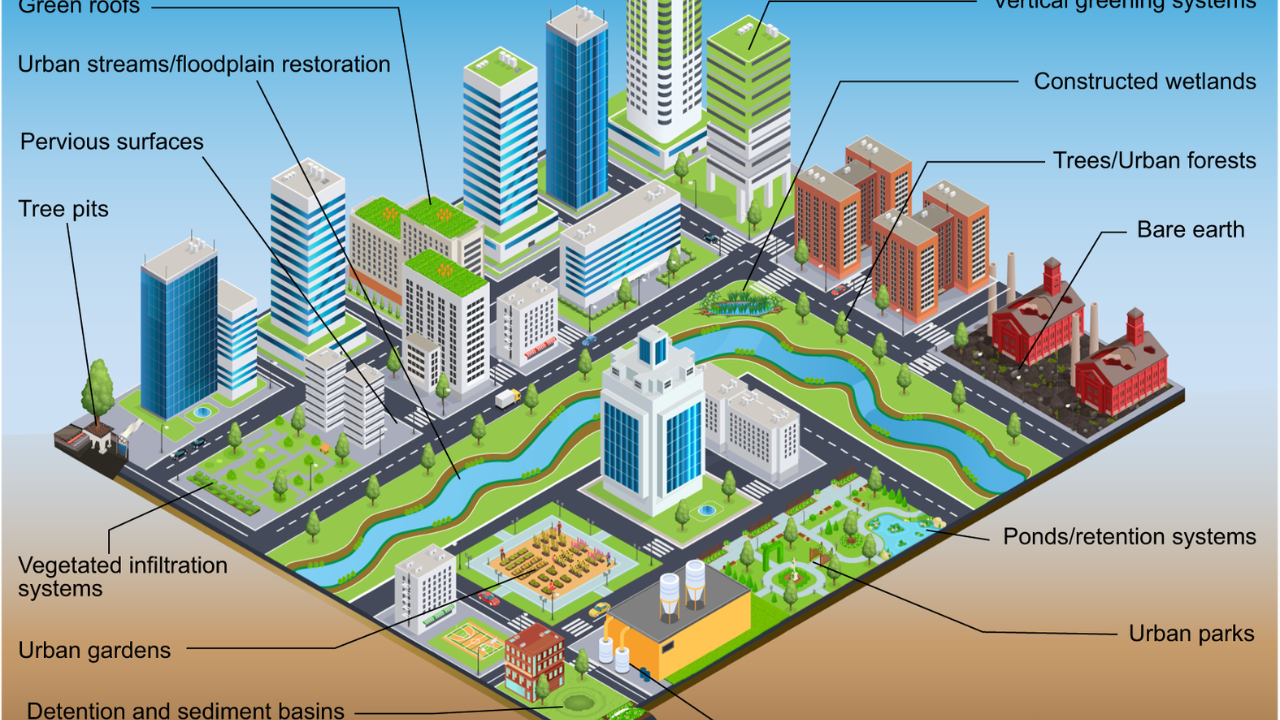
Green infrastructure and eco-friendly urban planning are no longer buzzwords—they are essential strategies for building sustainable, resilient cities. As urbanization accelerates, traditional concrete-heavy development has strained ecosystems, increased flooding, worsened air quality, and created heat islands. Green infrastructure offers a nature-based solution by integrating ecological systems into the built environment. From rain gardens and green roofs to permeable pavements and urban forests, this approach helps cities tackle environmental challenges while improving quality of life.
Overview Table: Key Elements of Green Infrastructure and Urban Planning
| Component | Purpose |
|---|---|
| Green Roofs & Walls | Temperature regulation and improved air quality |
| Permeable Surfaces | Stormwater absorption and flood mitigation |
| Urban Forests | Shade, cooling, and carbon sequestration |
| Bioswales & Rain Gardens | Natural water filtration and drainage |
| Eco-Corridors | Wildlife habitat and ecological connectivity |
| Integrated Urban Planning | Long-term resilience and community wellbeing |
1. Understanding Green Infrastructure
Green infrastructure refers to a network of natural and semi-natural systems that deliver ecosystem services in urban areas. Unlike grey infrastructure (pipes, sewers, concrete), green infrastructure uses soil, vegetation, and water processes to provide solutions to urban problems.
Examples of green infrastructure include:
- Green roofs and living walls
- Street trees and green medians
- Constructed wetlands and detention ponds
- Rain gardens and bioswales
- Permeable pavements
This nature-based approach not only supports biodiversity but also integrates aesthetics and sustainability into urban form.
2. Urban Heat Island Effect and Mitigation
Cities tend to be significantly warmer than surrounding rural areas due to concrete, asphalt, and lack of vegetation—a phenomenon known as the Urban Heat Island (UHI) effect. Green infrastructure reduces UHI by increasing shade and evapotranspiration.
Effective strategies to reduce UHI:
- Tree-lined streets and urban canopy cover
- Reflective and green rooftops
- Cool pavements and vegetated sidewalks
- Pocket parks in dense neighborhoods
Incorporating vegetation into cityscapes lowers temperatures, improves thermal comfort, and reduces energy demand for cooling.
3. Stormwater Management and Flood Control
Conventional drainage systems often fail during heavy rains, leading to urban flooding. Green infrastructure absorbs and filters rainwater, slowing runoff and reducing pressure on stormwater systems.
Common systems for stormwater control:
- Bioswales: Shallow ditches with vegetation to absorb water
- Rain gardens: Planted depressions that collect stormwater
- Permeable pavements: Surfaces that allow water to soak through
- Retention ponds: Collect excess runoff and prevent flooding
This approach reduces both surface flooding and pollution in waterways.
4. Air Quality and Carbon Reduction
Trees, shrubs, and green surfaces act as natural air filters by trapping dust, absorbing pollutants, and removing carbon dioxide from the atmosphere.
Urban green strategies for air quality:
- Dense tree planting near roads and highways
- Vertical gardens in high-traffic zones
- Green walls around schools and hospitals
- Expanding urban forests and pocket woodlands
Cities like Singapore and Copenhagen have shown significant air quality improvements through urban greening.
5. Integrated Eco-Friendly Urban Planning
True transformation requires integrating green infrastructure into long-term urban planning. This means designing cities with interconnected green systems, policies for sustainability, and incentives for green building.
Elements of eco-conscious urban planning:
- Zoning laws that require green space
- Public transport-oriented development
- Incentives for green construction (e.g., LEED-certified buildings)
- Environmental Impact Assessments (EIAs) for all major projects
Planning must be participatory, inclusive, and data-driven, involving local communities and experts from multiple disciplines.
6. Social and Economic Benefits
Green spaces are not only good for the environment—they boost mental health, encourage physical activity, and foster social interaction. Economically, green infrastructure increases property values and reduces healthcare and energy costs.
Key benefits include:
- Stress reduction and improved mood
- Encouragement of walking, cycling, and outdoor activity
- Community gathering spaces that foster cohesion
- Job creation in landscape management and eco-construction
- Tourism boost through attractive green corridors
Cities that prioritize green infrastructure see a ripple effect of benefits across sectors.
Table: Comparing Traditional vs Green Urban Infrastructure
| Feature | Traditional (Grey) Infrastructure | Green Infrastructure |
|---|---|---|
| Water Management | Concrete drains and pipes | Rain gardens, bioswales, permeable paving |
| Heat Mitigation | Asphalt, dark roofs | Tree canopy, green roofs, urban parks |
| Air Quality | No contribution | Absorbs pollutants and CO₂ |
| Cost Over Time | High maintenance and upgrades | Lower lifecycle cost, higher upfront value |
| Aesthetic Appeal | Minimal | Visually appealing and community-friendly |
| Wildlife Habitat | Absent | Supports birds, insects, and plant life |
3 Best One-Line FAQs
1. What is the role of green infrastructure in urban areas?
It manages stormwater, reduces urban heat, improves air quality, and supports biodiversity.
2. Can green infrastructure save money for cities?
Yes, it lowers long-term maintenance costs and reduces environmental damage-related expenses.
3. How does green urban planning benefit residents?
It improves health, comfort, and community engagement while making cities more resilient to climate change.
Conclusion
Green infrastructure and eco-friendly urban planning offer a hopeful, practical path forward in the face of climate change, pollution, and overcrowding. By embedding natural systems into city life, urban planners can build environments that are healthier, cooler, safer, and more livable. This shift is more than a trend—it’s a necessary evolution of how we imagine and shape our urban future. Every tree planted, every rain garden installed, and every eco-friendly building constructed is a step toward a more sustainable, equitable world.

